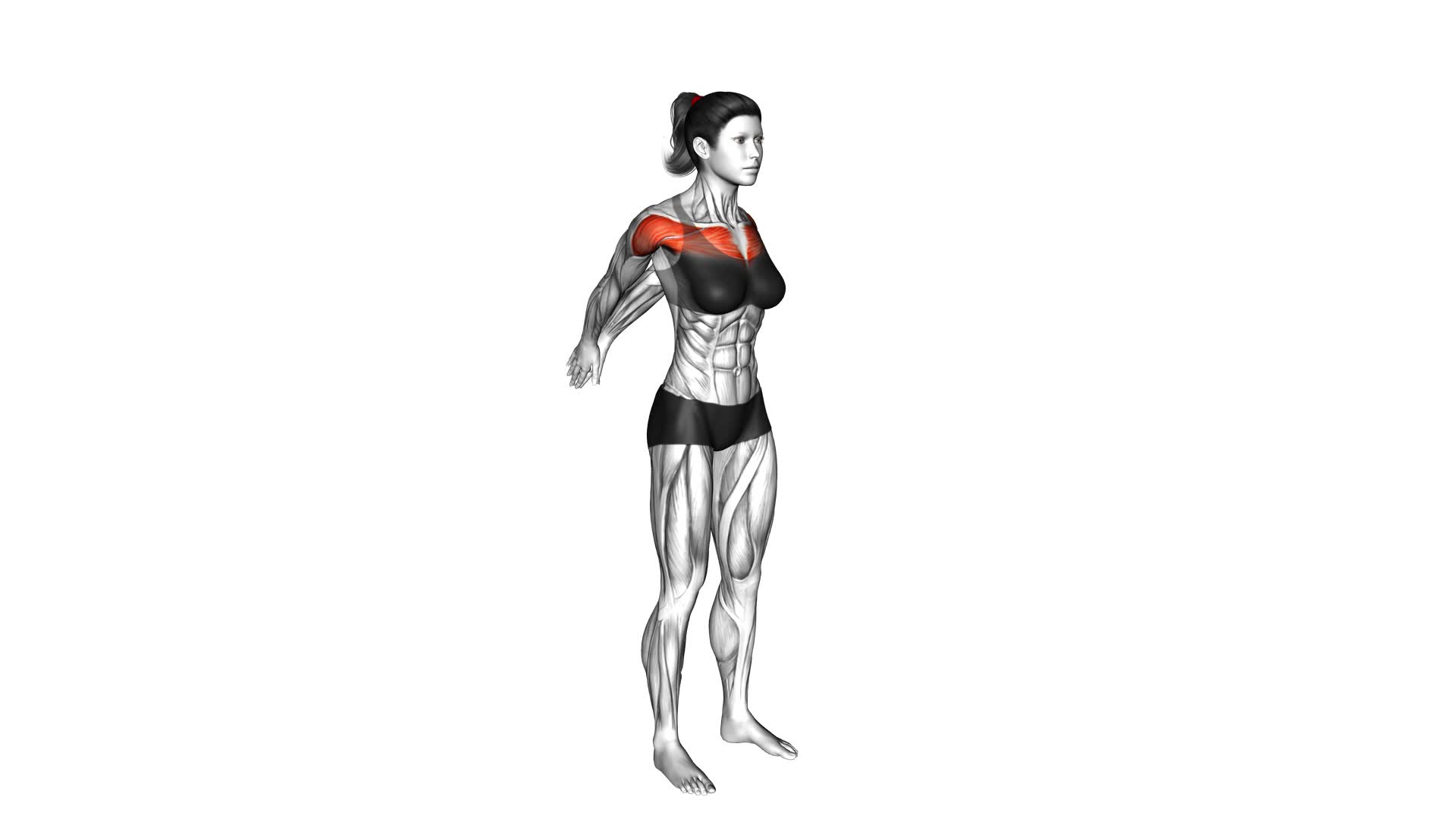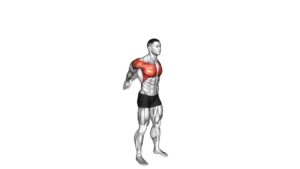Behind the Back Clap (female) – Video Exercise Guide & Tips

Looking to add some excitement to your workout routine? Check out this video exercise guide and tips for the behind the back clap (female) exercise.
Watch This Exercise Video
You'll learn the benefits of this move, proper form and technique, progressions and modifications, and common mistakes to avoid.
Plus, we'll give you some tips on how to incorporate the behind the back clap into your workout routine for maximum results.
Get ready to level up your fitness game!
Key Takeaways
- Improved cardiovascular fitness
- Strengthened upper body muscles (chest, shoulders, triceps)
- Engaged core muscles for improved stability
- Multiple health benefits from incorporating the exercise
Benefits of Behind the Back Clap
You can experience several benefits when incorporating the Behind the Back Clap exercise into your workout routine. This exercise offers numerous health benefits and helps activate multiple muscles in your body.
One of the main health benefits of the Behind the Back Clap exercise is improved cardiovascular fitness. This exercise requires a high level of intensity and engages your cardiovascular system, helping to increase your heart rate and improve overall cardiovascular endurance.
Additionally, the Behind the Back Clap exercise helps to strengthen your upper body muscles, including your chest, shoulders, and triceps. The explosive movement involved in clapping behind your back activates these muscles and helps to increase their strength and power.
Furthermore, the Behind the Back Clap exercise also engages your core muscles. As you perform the exercise, you need to stabilize your core to maintain balance and control. This leads to improved core strength and stability over time.
Incorporating the Behind the Back Clap exercise into your workout routine can provide you with multiple health benefits, including improved cardiovascular fitness, increased upper body strength, and enhanced core stability. Now, let's dive into the details of proper form and technique for this exercise.
Proper Form and Technique
To execute the Behind the Back Clap exercise with proper form and technique, it's essential to maintain a strong and engaged upper body throughout the movement. Start by standing with your feet shoulder-width apart and your arms relaxed by your sides.
Begin the exercise by raising your arms straight out in front of you, parallel to the ground. Next, quickly swing your arms backward, crossing them behind your back. As you do this, focus on squeezing your shoulder blades together and keeping your chest lifted. Then, rapidly bring your arms back to the starting position, clapping your hands together in front of you.
Remember to keep your core engaged and your back straight throughout the movement to maintain stability and prevent injury.
There are a few common errors to watch out for when performing the Behind the Back Clap. Avoid rounding your shoulders or hunching your back, as this can place unnecessary strain on your upper body. Additionally, be sure to use controlled and deliberate movements, rather than relying on momentum, to get the most out of the exercise.
If you're looking to add some variation or modifications to the Behind the Back Clap, you can try using resistance bands or dumbbells to increase the intensity. You can also experiment with different arm positions, such as starting with your arms raised overhead or holding them out to the sides. These variations can target different muscles and add variety to your workout routine.
Remember to always listen to your body and modify the exercise as needed to suit your fitness level and goals.
Progressions and Modifications
To progress and modify the Behind the Back Clap exercise, consider adding resistance or experimenting with different arm positions. Progressions and modifications can help challenge your muscles in new ways and prevent plateaus in your fitness journey.
One way to progress the Behind the Back Clap exercise is by adding resistance. You can use resistance bands, dumbbells, or even a weighted vest to make the exercise more challenging. By incorporating resistance, you'll engage your muscles even more and promote strength gains.
Another modification to try is experimenting with different arm positions. Instead of clapping behind your back, you can try clapping in front of your chest or overhead. These variations will target different muscle groups and provide a different stimulus to your body.
Remember to start with a weight or resistance level that challenges you but still allows you to maintain proper form. As you become more comfortable, gradually increase the resistance or try more difficult arm positions.
Common Mistakes to Avoid
Avoiding common mistakes while performing the Behind the Back Clap exercise can help ensure proper form and maximize the effectiveness of the movement. Here are some technique tips to keep in mind to avoid these common mistakes.
- One common mistake isn't maintaining proper posture throughout the exercise. It's important to keep your back straight and shoulders down to prevent straining the neck and upper back.
- Another mistake is using momentum to perform the clap instead of relying on the strength of your muscles. This can compromise the effectiveness of the exercise and increase the risk of injury. Remember to engage your core and focus on controlled movements.
- Another mistake to avoid is clapping too forcefully behind your back. This can strain your shoulders and wrists. Instead, aim for a gentle clap, focusing on the contraction of your muscles. Additionally, make sure to keep your elbows close to your body during the movement. This helps to target the correct muscles and prevents unnecessary strain on the shoulders.
- Lastly, it's important to avoid rushing through the exercise. Take your time and focus on the quality of each repetition. This will ensure that you're engaging the correct muscles and getting the most out of the exercise.
Tips for Incorporating Behind the Back Clap Into Your Workout Routine
Are you wondering how to incorporate the Behind the Back Clap exercise into your workout routine for optimal results? Look no further! Here are some tips to help you make the most out of this challenging exercise.
Firstly, when it comes to workout variations, there are a few different ways you can incorporate the Behind the Back Clap into your routine. One option is to perform it as a standalone exercise, focusing solely on building power and explosiveness in your upper body. Another option is to include it as part of a full-body circuit, combining it with other exercises to create a high-intensity workout.
In terms of muscle groups targeted, the Behind the Back Clap primarily works the muscles in your upper body, including your shoulders, chest, and triceps. However, it also engages your core muscles as you stabilize your body during the movement.
To get the most out of this exercise, it's important to maintain proper form throughout. Keep your core engaged, your back straight, and your shoulders down and back. Start with smaller claps and gradually increase your range of motion as you become more comfortable and confident.
Incorporating the Behind the Back Clap into your workout routine can add a fun and challenging element to your training. Remember to start slow, focus on form, and listen to your body to avoid injury. Happy clapping!
Frequently Asked Questions
Can the Behind the Back Clap Exercise Help Improve Upper Body Strength?
Yes, the behind the back clap exercise can definitely help improve your upper body strength. By incorporating this exercise into your full body workout routine, you can target and strengthen your shoulder muscles, chest, and arms.
To perform this exercise with proper form and technique, start by standing with your feet shoulder-width apart and then clap your hands behind your back, squeezing your shoulder blades together. Be sure to engage your core and maintain a neutral spine throughout the movement.
Is It Necessary to Warm up Before Attempting the Behind the Back Clap Exercise?
Before attempting the behind the back clap exercise, it's highly recommended that you warm up. Warming up helps to prepare your muscles and joints for the physical activity, reducing the risk of injury. It increases blood flow and flexibility, making your body more responsive to the exercise.
Additionally, it's important to be aware of common mistakes to avoid during this exercise, such as using excessive force or improper form. Proper warm-up and technique are key to a safe and effective workout.
How Many Repetitions of the Behind the Back Clap Exercise Should Be Performed in Each Workout?
To improve coordination and reap the benefits of plyometric exercises, it's important to know how many repetitions of the behind the back clap exercise should be performed in each workout. By focusing on the current question, you can ensure that you're getting the most out of your training.
The number of repetitions can vary depending on your fitness level and goals, but starting with 3 sets of 10 reps is a good place to begin. Remember to listen to your body and gradually increase the intensity as you progress.
Can the Behind the Back Clap Exercise Be Modified for Individuals With Shoulder or Wrist Injuries?
You may be wondering if the behind the back clap exercise can be modified for those with shoulder or wrist injuries. The good news is that there are modifications available for both.
If you have a shoulder injury, you can try performing the exercise with lighter weights or even just using your own body weight.
For wrist injuries, you can try using wrist wraps or performing the exercise with a neutral grip.
Remember to always listen to your body and consult with a professional if needed.
Are There Any Alternative Exercises That Can Be Performed Alongside the Behind the Back Clap to Target the Same Muscle Groups?
Looking for alternative exercises to target the same muscle groups as the behind the back clap? There are a few options you can try.
One is the bent over reverse fly, which works the upper back and shoulders.
Another is the seated row, which targets the back muscles.
And don't forget about the dumbbell row, a great exercise for the back and biceps.
Give these alternatives a shot to switch up your routine and keep those muscle groups engaged.
Conclusion
Incorporating the behind the back clap exercise into your workout routine can be a great way to improve upper body strength and coordination.
By following proper form and technique, avoiding common mistakes, and gradually progressing the difficulty level, you can maximize the benefits of this exercise.
Whether you're a beginner or advanced fitness enthusiast, this exercise can be modified to suit your fitness level.
So give it a try and take your workout to the next level!

Author
Years ago, the spark of my life’s passion ignited in my mind the moment I stepped into the local gym for the first time. The inaugural bead of perspiration, the initial endeavor, the very first surge of endorphins, and a sense of pride that washed over me post-workout marked the beginning of my deep-seated interest in strength sports, fitness, and sports nutrition. This very curiosity blossomed rapidly into a profound fascination, propelling me to earn a Master’s degree in Physical Education from the Academy of Physical Education in Krakow, followed by a Sports Manager diploma from the Jagiellonian University. My journey of growth led me to gain more specialized qualifications, such as being a certified personal trainer with a focus on sports dietetics, a lifeguard, and an instructor for wellness and corrective gymnastics. Theoretical knowledge paired seamlessly with practical experience, reinforcing my belief that the transformation of individuals under my guidance was also a reflection of my personal growth. This belief holds true even today. Each day, I strive to push the boundaries and explore new realms. These realms gently elevate me to greater heights. The unique combination of passion for my field and the continuous quest for growth fuels my drive to break new ground.







